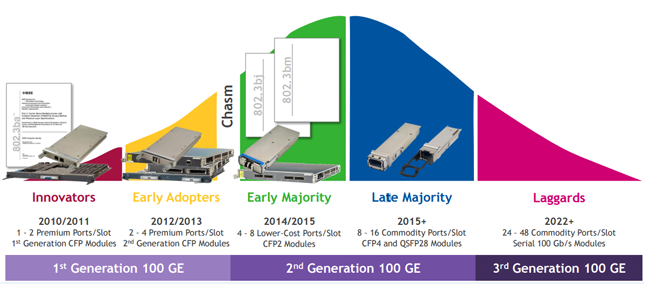Since 2010, the 100GbE transceivers have begun to appear on the market. After 5 years of evolution, 100G transceivers are becoming more and more suitable for the modern 100GbE network and the high-density data center. What evolution are there in the last 5 years? And what’s the nowadays mainstream 100GbE transceiver?
We divide the 100GbE development as three generation by 2022. The first generation 100GbE transceivers include the innovators 1-2 premium ports/slot 1st generation CFP modules (2010/2011) and 2-4 premium ports/slot 2nd generation CFP modules (2012/2013). Since last year, we have entered to the 2nd generation 100GbE transceivers age. 4-8 lower-cost ports/slots CFP2 modules have gradually replaced the CFP. Today, CFP4 and QSFP28 modules with smaller size and lower cost are more popular in the market. So, how about the 3rd generation 100GbE transceivers? The time will show you. But it is no doubt that the 3rd generation 100GbE transceivers will be more suitable for the requirement of the future 100GbE network, maybe with more than 24-48 ports/slots serial design.

By the end of 2015, 100GbE equipment will be widely deployed. As Andrew Schmitt, research director for carrier transport networking at IHS Infonetics said: “Next year (2016) is going to be huge for 100GbE.” Thus, the prospect of the 100GbE transceivers market will be better. At the same time, the development of 100GbE transceivers will be faster.
As we describe above, today, two new form factors are competing to become the successor to CFP and CFP2: CFP4 and QSFP 28. What’s the difference of them and which is better? CFP4 is slightly wider and longer than QSFP28 while both are about four times smaller than the original CFP. Both support modules of less than 6W of power consumption. In fact, QSFP28 can even achieve 3.5W. Despite the size and performance advantages of QSFP28, stacking it is more difficult than belly-to-belly CFP4 due to heat, signal integrity and EMI considerations. But, if the manufacturer is willing and able to cope with the stacking challenge, QSFP28 is indeed the superior choice. The remaining mystery is: who will be first to achieve 40KM distances, if anybody.
No matter which type of 100GbE transceivers will be the winner of future 100GbE network, the size of 100GbE transceiver modules will be smaller to be suitable to the high-density data center and the cost will be lower to save the project budget. Let’s look forward to it.





